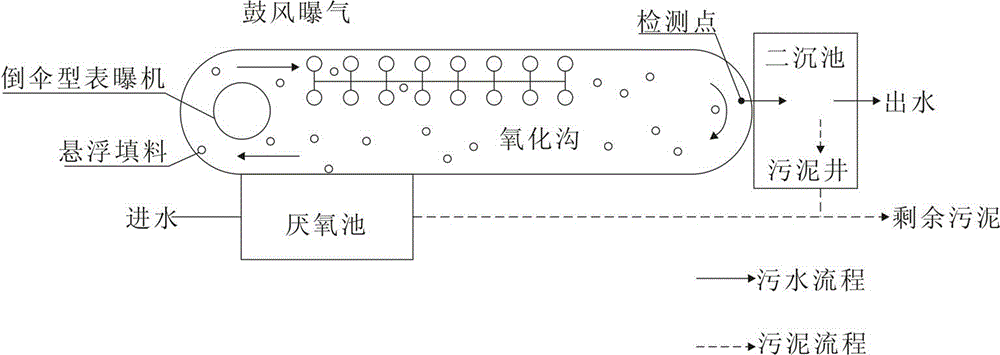Treatment method for municipal sewage through filling material and oxidation ditch combined process
A technology of urban sewage and composite process, applied in the field of sewage treatment, can solve problems such as unstable operation, prone to sludge bulking, and limited scale of biofilm process
- Summary
- Abstract
- Description
- Claims
- Application Information
AI Technical Summary
Problems solved by technology
Method used
Image
Examples
Embodiment Construction
[0008] The oxidation ditch is divided into aerobic section, anoxic section and pre-anaerobic section. Process flow like figure 1 Shown. Sewage enters the anaerobic tank from the inlet pipe first, and then enters the anoxic zone of the oxidation ditch through the bottom of the anaerobic tank after being stirred and mixed with the return sludge. Add fillers uniformly in the oxidation ditch. The sewage flows through the aerobic zone of the oxidation ditch, part of it enters the secondary sedimentation tank through the outlet of the oxidation ditch, and the other part returns to the anoxic zone and continues to circulate in the oxidation ditch. The sewage entering the secondary settling tank is separated from mud and water, and the supernatant is discharged as the effluent of the system. The settled activated sludge enters the sludge well through the channel at the bottom of the secondary settling tank. The sludge return pump in the sludge well returns the sludge to the anaerobi...
PUM
| Property | Measurement | Unit |
|---|---|---|
| diameter | aaaaa | aaaaa |
| height | aaaaa | aaaaa |
| power | aaaaa | aaaaa |
Abstract
Description
Claims
Application Information
 Login to View More
Login to View More - R&D
- Intellectual Property
- Life Sciences
- Materials
- Tech Scout
- Unparalleled Data Quality
- Higher Quality Content
- 60% Fewer Hallucinations
Browse by: Latest US Patents, China's latest patents, Technical Efficacy Thesaurus, Application Domain, Technology Topic, Popular Technical Reports.
© 2025 PatSnap. All rights reserved.Legal|Privacy policy|Modern Slavery Act Transparency Statement|Sitemap|About US| Contact US: help@patsnap.com

